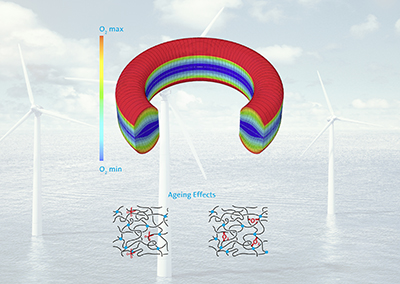 The seals used in plant engineering must have a very long service life. Once they are installed — to protect offshore wind turbine towers from salt corrosion, for example — customers (typically) require that they perform perfectly for more than 20 years. The service life of a seal is limited on the one hand by setting or stretching (physical relaxation). On the other hand, the material loses its elasticity over time due to chemical changes.
The seals used in plant engineering must have a very long service life. Once they are installed — to protect offshore wind turbine towers from salt corrosion, for example — customers (typically) require that they perform perfectly for more than 20 years. The service life of a seal is limited on the one hand by setting or stretching (physical relaxation). On the other hand, the material loses its elasticity over time due to chemical changes.
Under the influence of atmospheric oxygen or ozone, two basic effects that influence the aging of seals can be observed: First, the polymer chains and networks can fracture under mechanical stress, and second, additional oxygen bridges can develop in the network as a result of oxidation processes. Both effects influence important properties of relevance for seals such as stiffness, contact pressures or the ability to regain their original shape after deformation, also referred to as resistance to deformation.
To determine whether a material actually meets the requirements for a specific application, engineers usually conduct so-called “storage tests” in which the test specimen is exposed to temperatures well over 100° C for a longer period of time — usually 1,000 hours — to predict temperature-dependent aging. Engineers typically extrapolate the measured values using the Arrhenius Equation, a method named after the Swedish chemist and Nobel Prize winner Svante August Arrhenius. The equation is a formula for the temperature dependence of reaction rates where an increase in temperature by 10 °C leads to a doubling of the reaction rate. This enables predictions to be made using accelerated aging tests at elevated temperatures. When the correct test parameters are chosen, the test method functions reliably. In the absence of correct parameters, however, prediction of service life is inaccurate and can only be checked with measurements that require long testing periods. An improved methodology was required.
Freudenberg’s material experts used a dual approach to develop a new process. They significantly improved the service life model by coupling chemical oxidation equations — for example, the oxygen attack on the elastomer — with the structural-mechanical behavior of the material. In order to efficiently calculate any possible geometry, the new method was numerically based and employed a commercial finite element program. It is now possible to calculate local oxidation processes and their effect on materials’ mechanical behaviors using the Freudenberg method.
At the same time, Freudenberg experts also further developed the measurement methods used to determine the parameters for the material model to calculate the amount of oxygen consumed during the aging process, for example. The amount of oxygen is an important parameter for estimating the extent of the chemical attack.
“Thanks to the improvement of the measurement methods as well as the material model and the applicability to three-dimensional components, a precise method for predicting the service life has now been developed,” said Dr. Boris Traber, who is responsible for global advance material development at Freudenberg Sealing Technologies.
The process was developed jointly with Freudenberg’s corporate research department, Freudenberg Technology Innovation, and was first verified on material samples with different diameters. It is now being applied to initial applications including construction of offshore wind turbines. Traber sees this as only the beginning of a new simulation era.
“In the future, we will be able to provide our customers in plant construction with a reliable best-before date even over very long periods,” he said.
At present, a library with models for various materials and component geometries is being set up. At the same time, simulation is being expanded so that application-specific cycles with changing temperatures and mechanical loads can also be calculated.
Freudenberg Sealing Technologies
www.fst.com

Leave a Reply